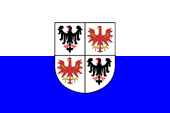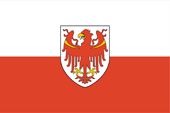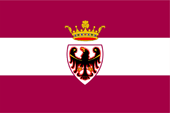Trient-Südtirol
|
|
|
|
| Übersicht – Contents: | |
Diese Seite ist Teil des Projektes
Trient-Südtirol
|
|
|
|
| Übersicht – Contents: | |
Flagge – Flag: |
|
 |
Flagge von Trient-Südtirol – flag of Trentino-South Tyrol, Seitenverhältnis – ratio = 2:3, Quelle/Source: nach/by: Wikipedia (D) |
Flaggen der Provinzen – flags of the provinces: |
|
 |
Offizielle Flagge von Südtirol (Alto-Adige) – Official flag of South Tyrol (Alto-Adige), Seitenverhältnis – ratio = 2:3, Quelle/Source nach/by: F l a n k e r / CC BY via: Wikipedia (D) |
 |
Offizielle Flagge von Welschtirol (Trentino) – Official flag of the Trento Province, Seitenverhältnis – ratio = 2:3, Quelle/Source nach/by: User:Fulvio314 / Public domain, via: Wikipedia (D) |
Bedeutung/Ursprung der Flagge – Meaning/Origin of the Flag: |
|
| Die Flagge von Trient-Südtirol zeigt zwei horizontale Streifen in Weiß und Blau, und in der Mitte das Wappen der Region. Es ist ein gevierter silberner Schild, der im ersten und vierten Feld einen schwarzen Wenzelsadler zeigt, die Heraldik der Stadt Trient, und im zweiten und dritten Feld den roten Adler von Tirol. Der Wenzelsadler ist ein besonderes heraldisches Symbol, nämlich ein Adler aus dem kleine Flammen züngeln. Die Herkunft der Farben der Flagge ist nicht geklärt. | The Flag
of Trentino-Alto Adige shows two horizontal stripes in white and blue, and
in the middle the coat of arms of the region. It is a quartered, silvery
shield, which shows a black Eagle of Wenzel in the first and fourth field,
the heraldry of the city of Trento, and in the second and third the red
Eagle of Tyrol. The Eagle of Wenzel is a special heraldic symbol, namely an eagle darting tongue small flames from it. The origin of the colors of the flag is not cleared. |
| Quelle/Source: Wikipedia (D), Volker Preuß | |
Landkarte der
Regionen Italiens – Map of the Regions of Italy: |
|
| Landkarte/Map: Volker Preuß |
| Landkarte der Region Trient-Südtirol – map of the region Trentino-Alto Adige: |
|
Zahlen und Fakten – Numbers and Facts: |
|
|
|
|
|
|
|
|
|
|
|
|
|
|
|
|
Geschichte: |
|
8000 v.Chr. · aus Illyrern, Iberern und Ligurern sowie später
eingewanderten Kelten und Etruskern entwickelt sich das Volk der Räter 25 v.Chr. · römische Eroberung, das Gebiet Bozen (Südtirol) kommt zur Provinz Raetia, das Gebiet Trient zur Provinz Italia 476 · Absetzung des letzten römischen Kaisers Romulus Augustulus, Ende des (West)Römischen Reiches, Trient-Südtirol gehört bis 493 zum Reich des Odoaker 550–700 · Einfälle von Franken, Langobarden, Bajuwaren und Slawen 8. Jhd. · Trient-Südtirol kommt zum Frankenreich 843 · bei der Teilung des Frankenreiches kommt Trient-Südtirol zum Königreich Italien, später zum Deutschen Königreich 961 · Otto I. bringt Trient-Südtirol an das Deutsche Königreich 1363 · die Habsburger erwerben Tirol, und teilweise Macht über das Bistum Trient 1511 · das Bistum Trient wird österreichisches Protektorat 1803 · Trient wird Österreichisch-Tirol angeschlossen 1805 · Bayern erwirbt Tirol 1810 · Tirol wird zwischen Bayern (Nordtirol) und Napolèonisch Italien (Südtirol) aufgeteilt 1815 · Wiener Kongress, ganz Tirol (mit Trient) wird Österreich wieder angegliedert 1919 · Friedensvertrag von St. Germain, Österreich muss Südtirol und Trient an Italien abtreten, Trient-Südtirol wird als Provinz "Venetia Tridentina" Italien angegliedert 1948 · Bildung der autonomen Region "Trienter Land - Oberes Etschland" (Trentino-Alto Adige) bestehend aus der Provinz Trient und der Provinz Bozen (Südtirol) 1957 · Autonomiestatut für die Provinz Bozen (Südtirol) 1992 · Abkommen zwischen Österreich und Italien bestätigen und bekräftigen den Autonomiestatus der Region und der Provinz Bozen (Südtirol) |
History: |
|
8000 B.C. · from Illyrians, Iberians and Ligurians as well as later
immigrated Celts and Etruscians evolves the people of the Raetians 25 B.C. · Roman conquest, the Bolzano Area (South Tyrol) comes to the Province of Raetia, the Trento Area to the Province of Italia 476 · dismissal of the last Roman emperor Romulus Augustulus, end of the (West)Roman Empire, Trento-South Tyrol belongs until 493 to the Empire of the Odoaker 550–700 · invasions of Franks, Langobardes, Bajuwares and Slavs 8th cent. · Trento-South Tyrol comes to the Frankish Empire 843 · with the partition of the Frankish Empire comes Trento-South Tyrol to the Kingdom of Italy 961 · Otto I. brings Trento-South Tyrol to the German Kingdom 1363 · the House of Habsburg purchases Tyrol, and partially the control over the Diocese of Trento 1511 · the Diocese of Trento becomes an austrian protectorate 1803 · Trento gets connected with Austrian Tyrol 1805 · Bavaria purchases Tyrol 1810 · Tyrol gets partitioned between Bavaria (North Tyrol) and Napolèonic Italy (South Tyrol) 1815 · Vienna Congress, whole Tyrol (with Trento) becomes incorporated into Austria again 1919 · peace treaty of St. Germain, Austria has to cede South Tyrol and Trento to Italy, Trento-South Tyrol gets incorporated as Province of "Venetia Tridentina" into Italy 1948 · formation of the autonomous region "Trento Country - Upper Etsh Land" (Trentino-Alto Adige) consisting in the Province of Trento and the Province of Bolzano (South Tyrol) 1957 · autonomy statute for the Province of Bolzano (South Tyrol) 1992 · agreements between Austria and Italy confirm and corroborate the autonomy status of the region and the province Bolzano (South Tyrol) |
| Quelle/Source: Atlas zur Geschichte, Wikipedia (D) |
Südtirol
|
|
|
|
| Übersicht – Contents: | |
Flaggen – Flags: |
|
 |
offizielle Flagge von Südtirol – official flag of South Tyrol, Seitenverhältnis – ratio = 2:3, Quelle/Source nach/by: F l a n k e r / CC BY via: Wikipedia (D) |
 |
Landesflagge (Landesfarben) – Flag of the country (colours), Seitenverhältnis – ratio = 2:3, Quelle/Source: Wikipedia (D), Färbung/colour nach/by Dr. Peter Diem www.peter-diem.at |
Bedeutung/Ursprung der Flagge – Meaning/Origin of the Flag: |
|
| Die Provinz Südtirol hat im Sinne des Neuen Autonomiestatutes (Art. 3) das Recht, neben einem eigenen Wappen, auch ein eigenes Banner zu führen. Das Landeswappen ist bereits 1983 genehmigt worden, das Banner erhielt hingegen erst im Herbst 1996 die endgültige Zustimmung der zuständigen römischen Stellen und ist auf Antrag der Südtiroler Landesregierung (einstimmiger Beschluss vom 7. Oktober 1996) am 21. November 1996 mit Dekret des Staatspräsidenten genehmigt worden. Das Banner ist in der Mitte mit dem Landeswappen belegt. | The
Province of South Tyrol has the right, in the sense of the
New Statute of Autonomy
(Article 3), to keep its own coat of arms and its own flag.
The coat of arms was approved in 1983, the flag gets the final approval by the Roman authorities not before the fall of the year 1996, and was approved by the South Tyrolean government (unanimous decision of 7th of October in 1996) on 21st of November in 1996 by decree of the President. In the middle of the flag is placed the coat of arms. |
| Die
Flagge von Tirol stammt aus dem frühen 19. Jahrhundert und zeigt zwei
Streifen in Weiß und Rot. Sie wurde am 10.03.1949 eingeführt. Die Farben der Flagge leiten sich aus den Farben des Wappens ab (roter Adler auf Silber). |
The flag of Tyrol descents from the early 19. century and shows two stripes in white and red. It was introduced on 10th of March in 1949. The colours of the flag are derived from the colours of the coat of arms (red eagle on silvery ground). |
| In der Zeit der Monarchie hatte das Land, wie alle Kronländer der österreichischen Krone, seine eigenen, sogenannten Landesfarben, die unter anderem auf horizontal getreiften zwei- oder dreistreifigen Flaggen gezeigt wurden. Die Landesfarben waren sehr oft dem jeweiligen Wappen des Kronlandes entnommen oder wurden duch eine weitere, nicht im Wappen enthaltene Farbe ergänzt, oder sie gingen auf ältere Modelle des Landeswappens zurück (z.B. Krain). Offiziell waren die Landesfarben aber nie geregelt oder festgelegt worden, so dass deren Reihenfolge in der Praxis of variierte oder die Farben gar an sich abwichen. Der österreichische Heraldiker Hugo Gerard Ströhl (1851–1919) hat sich wohl als erster des Themas angenommen und wahrscheinlich um das Jahr 1890 herum die Landesfarben auf den Flaggen bei den jeweiligen Landesbehörden abgefragt und zusammengestellt. Für Tirol wurden Weiß und Rot als Landesfarben für das Kronland ermittelt. |
In the time of the
monarchy, the country had – like all the other crown lands of the Austrian
crown – its own colours (Landesfarben), which were used amongst others on
horizontally two- or three-striped flags. The colours (Landesfarben) were very often taken from the respective coat of arms of the country or were supplemented by another colour, which not appears in the coat of arms, or they went back to older models of the coat of arms (e.g. Carniola). Officially, the colours had never been regulated or stipulated, so that their sequence varied in practice or even the colors deviated. The Austrian heraldist Hugo Gerard Ströhl (1851–1919) was probably the first to take care of it and asked for the colors (Landesfarben) on the flags at the respective state authorities around 1890 and compiled them. For Tyrol, white and red were ascertained as the country's colors of the crown land. |
| Quelle/Source: Dr. Peter Diem austria-forum.org, Wikipedia (D), Flaggen Enzyklopädie, Flags of the World, Volker Preuß, Österreichisch-Ungarische Wappenrolle, Mirko Costa, Bruneck, Südtirol | |
Wappen von Südtirol – Coat of Arms of South Tyrol: |
|
 |
seit/since 1983, Wappen Provinz Bozen (Südtirol) – coat of arms of the Province of Bolzano (South Tyrol), Quelle/Source: Helga von Aufschnaiter, nach/by: F l a n k e r / Public domain via: Wikipedia (D) |
Bedeutung/Ursprung des Wappens – Meaning/Origin of the Coat of Arms: |
|
| "Das
Tiroler Wappen zeigt in silbernem Schild einen roten, golden bekrönten nach
heraldisch rechts blickenden Adler mit goldenen Waffen, mit goldenen
Flügelspangen mit Kleeblattenden und einem nach oben offenen grünen Kranz
hinter seinem Haupt." Zitat von Dr. Peter Diem auf: Flags of the World |
"The
Tyrolean coat of arms shows a red eagle on a silver shield with a golden
crown. The eagle looks to the heraldic right and is armed with golden claws
and legs, golden bars in the wings ending in a shamrock and a green wreath,
open on the top, behind its head." Quote of Dr. Peter Diem on: Flags of the World |
|
"
Das Alte Tiroler Landeswappen „roter Adler auf silbernem (weißem) Grund“ ist in
Abbildungen seit 1271/1286 farbig überliefert. Als älteste Darstellung gilt
das Fresko in der Kapelle von Schloss Tirol aus der Zeit von 1271 bis 1286.
Eine Beschreibung mit Angabe der Farben ist im Wappengedicht (Clipeus
Teutonicorum) des Domherren Konrad on Mure, das um 1250 entstanden ist,
enthalten: „Fert aquilam Tyrolis clipeus prestante rubore, que nigri pedis
est alias albente colore“ (Das weiße Schild Tirols
führt einen Adler von hervorstechender roter Farbe und schwarzen Füßen).
Zum Unterschied dazu war es seit dem 14. Jahrhundert üblich, die Fänge
und die Waffen des Adlers golden zu färben. Im Jahre 1416 erhielt der
Adler eine Krone, und im 1567 einen grünen Kranz um seinen Kopf." Zitat von: Mirko Costa, Bruneck, Südtirol |
"The
ancient coat of arms of Tyrol „red eagle on silvery (white) ground“ is
handed down in colored depictions since 1271 resp. 1286. As the oldest
reproduction counts the fresco in the chapel of Tyrol Castle in the times
between 1271 and 1286. A description – with details of the colours created about 1250 with the scutcheon-poem (Clipeus Teutonicorum) by the Canon Konrad on Mure – says: „Fert aquilam Tyrolis clipeus prestante rubore, que nigri pedis est alias albente colore“ (The white shield of Tyrol carrys an eagle of outsticking red colour and black feet). In difference was it since the 14th century usual to dye the catches and the arms of the eagle in gold. In the year 1416 the eagle got a crown and in 1567 a green wreath around its head." Quote of: Mirko Costa, Bruneck, Südtirol |
| Der Tiroler Adler wird in verschiedener Gestalt von verschieden politischen Körperschaften verwendet, so vom Österreichischen Bundesland Tirol, aber auch von der Autonomen Provinz Südtirol (Alto-Adige) und ähnlich auch in der Autonomen Provinz Trient (Trentino, in Deutsch: Welschtirol). Die beiden Autonomen Provinzen Südtirol und Trient bilden zusammen die Italienische Region Trient-Südtirol (Trentino-Alto-Adige). | The Tyrolean eagle is used in various forms by different political bodies, such as the Austrian federal country of Tyrol, but also by the Autonomous Province of South Tyrol (Alto-Adige) and similarly in the Autonomous Province of Trento (Trentino, in German: Welschtirol). The two autonomous provinces of South Tyrol and Trento together form the Italian region of Trento-South Tyrol (Trentino-Alto-Adige). |
| Der Adler ist im Prinzip immer der gleiche, nur orientierte man sich entweder an historischen Vorlagen, so wie das Wappen zu bestimmten Zeiten in einem bestimmten Jahrhundert ausgesehen hat, oder ein Künstler hat das Wappen neu gestaltet. So wurde das heutige Wappen des Bundeslands Tirol im Jahre 1946 geschaffen. Der Adler trägt die 1416 verliehene Krone und das Wappen zeigt den 1567 ergänzten grünen Kranz. Der grüne Kranz wurde quasi wiederbelebt, denn in den zurückliegenden Zeiten wurde auf dessen Darstellung verzichtet. Für Südtirol ist die Vorlage das Wappen der Grafen von Tirol, ausgeführt so wie auf der rechten Flügelaußenseite des Altars von Schloss Tirol aus dem Jahre 1370, mit goldenen Flügelspangen. Es wurde im Jahre 1982 von der Künstlerin Helga von Aufschnaiter neu gestaltet. In dieser Form wurde das Wappen im Jahre 1983 vom italienischen Staatspräsidenten bestätigt. Für Welschtirol (Provinz Trient) ist die Vorlage das Wappen, das Nikolaus Abrein, zwischen 1338 und 1347 Fürstbischof von Trient, im Jahre 1339 eingeführt hat. Es ist zwar auch ein Adler, jedoch schwarz, mit goldenen Flügelspangen und Kleeblattenden, in einem rotem Flammenkranz. Ein solches Adlermodell wird "Wenzelsadler" genannt, benannt nach St. Wenzel, ein Märtyrer und böhmischer Fürst aus dem herrschenden Geschlecht der Přemysliden aus der ersten Hälfte des 10. Jahrhunderts. |
In principle, the eagle
is always the same, only inspired by historical models,
as the coat of arms looked at specific times in a specific century, or an
artist redesigned the coat of arms. In this way the today's coat of arms of the federal country of Tyrol was created in 1946. The eagle bears the crown awarded in 1416 and the coat of arms shows the green wreath, which was added in 1567. The green wreath was practically revived, because in the past times it was not shown. For South Tyrol, the template is the coat of arms of the Counts of Tyrol, executed like on the right wing outside of the altar of Castle Tyrol from 1370, with golden wing clips. It was redesigned in 1982 by the artist Helga von Aufschnaiter. In this form, the coat of arms was confirmed in 1983 by the Italian President. For Welschtirol (Province of Trento) the template is that coat of arms which Nikolaus Abrein, Prince-Bishop of Trento between 1338 and 1347, introduced in 1339. It is also an eagle, but black, with golden wing clips and shamrock ends, in a red flame wreath. Such an eagle model is called "Wenceslas Eagle", named after St. Wenceslas, a martyr and Bohemian prince from the ruling Přemyslid family from the first half of the 10th century. |
| Quelle/Source: Wikipedia (D), Flaggen Enzyklopädie, Dr. Peter Diem on: Flags of the World, Mirko Costa, Bruneck, Südtirol, Volker Preuß, Österreichisch-Ungarische Wappenrolle | |
|
Landkarte der Region Trient-Südtirol – map of the region Trentino-Alto Adige: |
|
Zahlen und Fakten – Numbers and Facts: |
|
|
|
|
|
|
|
|
|
|
|
|
|
|
|
|